Inflated caterpillars
There are several ways to preserve caterpillars for study. You can boil them and drop them into a jar of alcohol, you can freeze dry them, or you can inflate them.
Inflate them?
Yes indeed.
The photos in this post are all of inflated caterpillars, in the genus Acronicta, found at the Cornell University Insect Collection (CUIC).
Acronicta albarufa
Inflating (or “blowing”) caterpillars is a traditional technique that is no longer taught or commonly used, however it can produce fabulous results. The caterpillar remains dry and can be kept in a drawer along with adults, which makes them easier to study than specimens in alcohol. Their external features are usually well maintained – specimens from the early 1900s don’t look much different from modern specimens.
However they are lacking their internal organs, and the last couple of segments are destroyed in the preparation process. The technique is also quite labor intensive and requires unusual equipment. So how does it work?
Acronicta aceris
I have talked to a few entomologists who have inflated caterpillars, but not since their undergraduate or graduate school days. I have found a few resources which describe the process. Here is a description from the University of Minnesota Agricultural Experiment Station:
Basically you cut a slit into the posterior end of the caterpillar, and using a pencil, roll out the guts (starting at the head end). You must be careful to not destroy the hairs and other features of the exterior. Then you insert a glass tube and inflate the caterpillar, and keep the caterpillar inflated as you heat it in a small make-shift oven. One colleague described using a coffee can over a bunsen burner for this purpose.
Once the caterpillar is dry, the glass tube is removed and the caterpillar can be prepared for pinning. Either a wire or stick can be inserted, or the caterpillar can be glued onto the wire or stick by its prolegs underneath the body.
A box of Acronicta americana adults, caterpillars, and pupae
From the photo above you can see that even caterpillars with lots of hairs can undergo this technique. In fact, they look incredibly lifelike.

Late (above) and early (below) instars of Acronicta morula
Another benefit of inflating caterpillars is that the body shapes are extended and not distorted by being kept in a liquid. The important bumps and hair positions are kept as their were in life. However the body may be a bit overextended depending on how well it was squished and inflated.
Acronicta psi
One reason I particularly enjoy the inflated caterpillars is that they are easy to transport and trade – so there are many European species in collections here in the USA. Caterpillars are not often kept in collections to begin with, so to have these specimens available to me for study is quite exciting.
As you can probably guess, I’m going to set up my very own caterpillar inflating oven as soon as I can! And I’ll have another post soon on even more inflated caterpillars I have found at other collections.
Sources: _____________________________________
University of Minnesota, 1908. 16th Annual Report of the Agricultural Experiment Station. Bulletin #105. How to Collect and Preserve Insects. Pages 119-146.
Posted on March 24, 2013, in Acronicta, Acronictinae, Invertebrates, Noctuidae and tagged caterpillar, caterpillar specimens, inflated caterpillar, larvae, preservation. Bookmark the permalink. 5 Comments.





This was an interesting post for me to encounter, because when I was at the University of Kentucky Medical Center in the 1980s, a colleague in the Pulmonary Division there resurrected an old technique for air-inflating (and dry-preserving) human and animal lungs. All that was needed was some Tygon tubing tied inside the trachea and then a gentle flow of dry air (which would diffuse or leak out of the lungs). The desiccation resulted in perfect preservation without the need for other chemicals.
I mention this only to suggest that when you try the technique on cats, you might run a few without the bunsen burner heat, which may not be completely necessary.
Hmm, I’ll try that and see if it works! My friends and I are all curious to see what methods will result in the best color preservation. I know freeze drying is the best, but those units aren’t exactly cheap.
HI Brigette when you freeze dry do you get any shrinking, or discoloration?
I likje the helpful information you provide on your articles.
I’ll bookmark your webloog annd test agan right here frequently.
I am rather sure I’ll be told plenty oof new stuff right here!
Best of luck for the following!
Pingback: Museum caterpillars part 2 | caterpillarblog